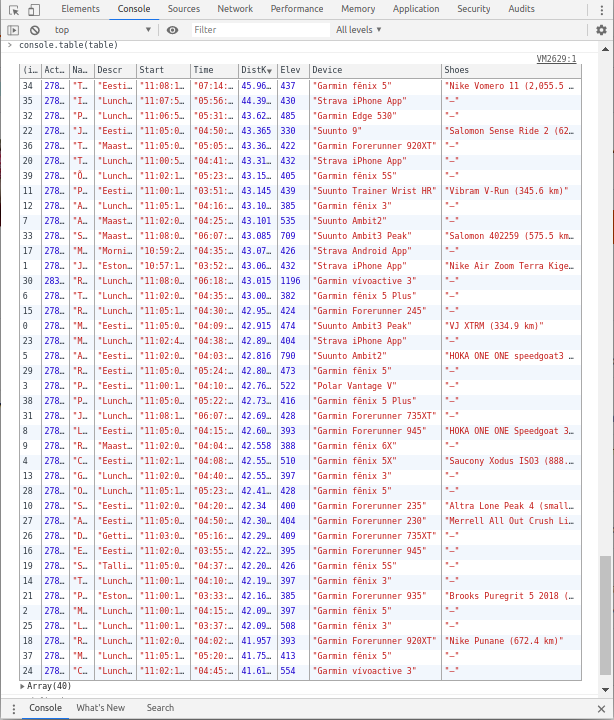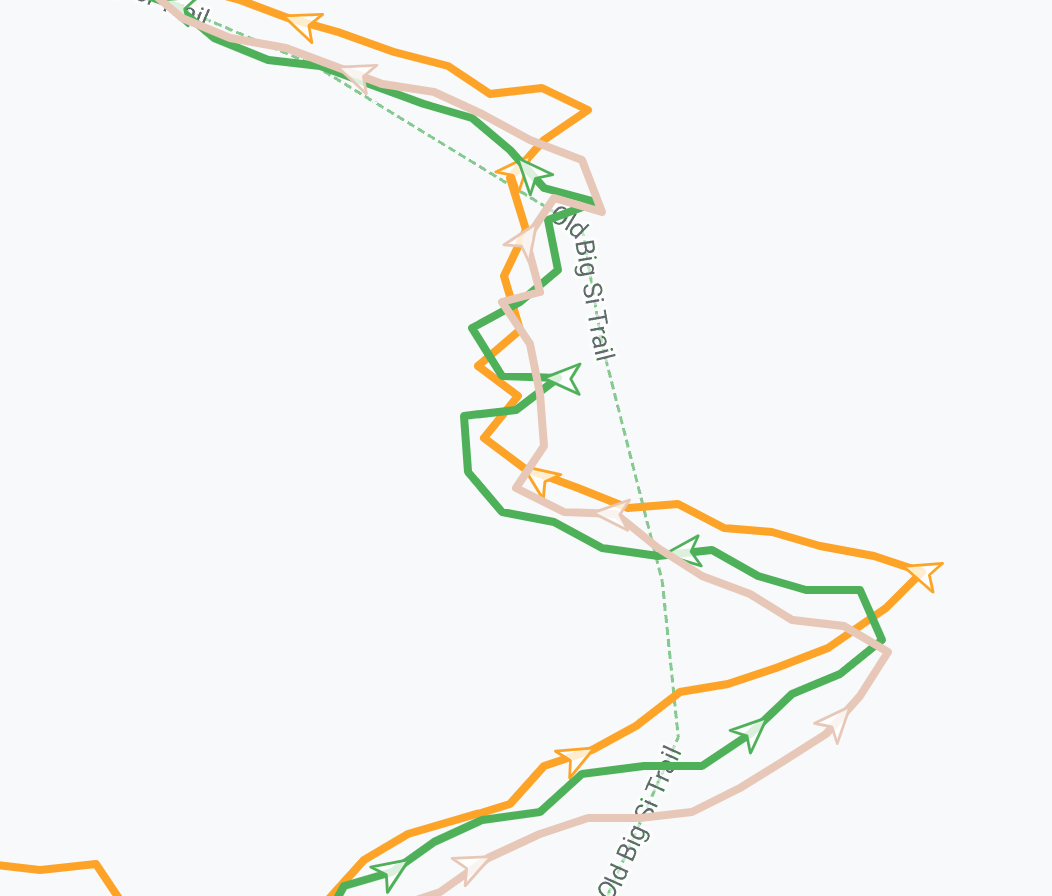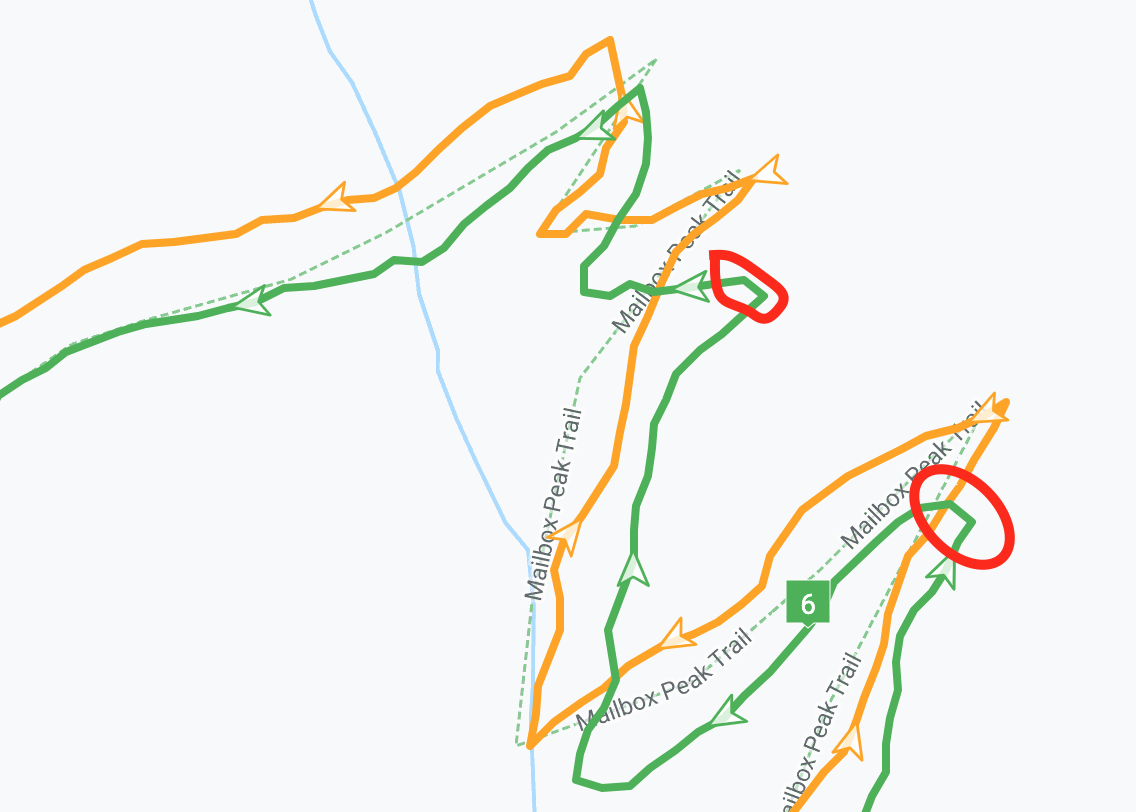-
@isazi said in Suunto 9 with the recent GPS firmware was among least accurate GPS watches in today's 25K trail race:
Never used Strava FlyBy before, but looks very cool to extract statistics from public events.
I’ve used it a lot but never thought of it as as such a data source. This stuff is pure gold :]

-
@margusl
it looks interesting… but what you don’t know is- watch settings
- firmware
- settings and firmware of competitor watches

… by this table, Fenix 3 finisher 4:10 nailed it
-
@margusl It is never occurred to me to use the developer tools console to print the data like this. I was opening them one by one. I’ll play with this more tonight. It should be possible to write a chrome extension that will automate extracting data like this.
Looking at this table I realize that slower runners would probably have a bias towards longer distance. When someone stops their GPS positions tend to wander around adding a bit of distance.
-
@Dimitrios-Kanellopoulos Here is the GPX file:
-
@TELE-HO said in Suunto 9 with the recent GPS firmware was among least accurate GPS watches in today's 25K trail race:
by this table, Fenix 3 finisher 4:10 nailed it
Keep in mind that in road marathons most runners end up running more than the actual marathon distance due to not following ideal tangents, waving around other runners, etc. Road race distances are measured following most straight possible path through every corner, etc.
-
@silentvoyager
 …yes I know… but people like to see (edit typo) 42.195km on their watches when they run a marathon, no matter how many other runners they have been circling and how many water stations they used…
…yes I know… but people like to see (edit typo) 42.195km on their watches when they run a marathon, no matter how many other runners they have been circling and how many water stations they used…
it is very hard to proof which watch is the most accurate as we don’t know some parameters.
I like to have an accurate watch, too.
The same run I did on Sunday and before that on Saturday last week showed 4m less ascent and 50meters more distance.
Could be anything from not exactly the same start/end or satellite reception (as I lost satellite reception a week ago I think this was it…) or I went around hikers in a different way…
What I want to say is that a proper statistical analysis is very difficult due to too many variables that we don’t know.
Some records are clearly off precision if you check them, no question. I hope we can help Suunto somehow to improve GPS distance and Baro ascents
edit: this is it by the way: https://beta.quantified-self.io/user/jBm0qOhihUMykVYD8HBJMshQrJc2/event/LZ8RKDysG9Csh4i367AG
edit 2: the rout planning showed 7.06km and 256m ascent…
-
@silentvoyager the distance only from GPS based points confirms your distance.
I would like to run the same analysis on the GPX file of the competition (eg route provided)
You can actually do that your self if you like so.
GPX files do not have distance summaries, so QS uses the vincety algo to calculate the distance out of track points.
For FIT files (dont rememember about TCX ) the distance is read from the file summary
-
@Dimitrios-Kanellopoulos I don’t know if I can get a GPX or FIT file for any other runners. Strava allows me to create a route from someone’s activity but apparently it now snaps the route to trails and that changes the distance.
-
@silentvoyager Good one. You are right it aint easy. I was more wondering about the realroute aka the declared distance.
-
@silentvoyager said in Suunto 9 with the recent GPS firmware was among least accurate GPS watches in today's 25K trail race:
@Dimitrios-Kanellopoulos I don’t know if I can get a GPX or FIT file for any other runners. Strava allows me to create a route from someone’s activity but apparently it now snaps the route to trails and that changes the distance.
Try this - https://mapstogpx.com/strava/ , it builds GPX from Strava data streams, i.e. while Strava route export is not involved, some filtering and processing might be.
@silentvoyager said in Suunto 9 with the recent GPS firmware was among least accurate GPS watches in today's 25K trail race:
When someone stops their GPS positions tend to wander around adding a bit of distance.
Close, but not quite there - this is more like an example where slower runners tend to forget themselves, and add some extra distance due being lost
 (F5 with longest distance spent about 30mins off route)
(F5 with longest distance spent about 30mins off route)@TELE-HO said in Suunto 9 with the recent GPS firmware was among least accurate GPS watches in today's 25K trail race:
@margusl
it looks interesting… but what you don’t know is- watch settings
- firmware
- settings and firmware of competitor watches

… by this table, Fenix 3 finisher 4:10 nailed it
Going too deep into limited data set that might or might not be already altered by someone will no be best use of ones time :] I can just say that there are multiple more significant factors there: rain, tripping wet forest, multiple start groups, neto timing, starting watch when already on the course, sightseeing, getting lost. Though It is possible to spot some trends and check if spread over distance and/or elevation somehow correlates with watch brand/antenna type/GPS chip/etc. Using Strava as a source also poses a huge bias on sample distribution: as a platform it does not appeal to everyone and it’s privacy settings form another filter. So I’d be very cautious to conclude anything out of this, definitely not most/least accurate watch. Consumer trends? Maybe. But knowing that doesn’t make this fiddling any less fun

-
@margusl said in Suunto 9 with the recent GPS firmware was among least accurate GPS watches in today's 25K trail race:
But knowing that doesn’t make this fiddling any less fun


-
yesterday and today I took short rides and compared on random/different short routes the track accuracies for Switzerland of the different GNSS combination settings…
my takeaway: it is a tiny slightly little bit more accurate with GPS+Galileo but definitely not worth the higher battery consumption.
I did not compare the distance of cours, as all routes are different.… but the activity with GPS+GLONASS has for 100% sure issues with the total ascent…
GPS+Galileo is way more realistic!
I suspect that the baro sensor holes was covered and it caused this pumping effect as I already know from Suunto Core… that’s a huge disadvantage and I hope that I don’t see this frequently. But to be honest, from a design engineer point of view: the location for the pressure sensor is a faulty design
especially when you have to tighten the strap enough to get halfway reasonable OHR readings… -
Here is a comparison between Ambit3 Peak, Suunto 9 with one year ago firmware, and Suunto 9 with the current firmware. The routes weren’t exactly the same, but there are some common parts that allow to do some comparisons.
https://quantified-self.io/user/JMRgYAdyBBXBsMbxUHGVRwlKoKq2/event/xT4vJjRS3TPvm8WuF6y2
I’d say that in general the track of Suunto 9 with the current firmware is improved - it stays closer to Ambit3 Peak track, especially on straight segments. But at the same time it has a tendency to cut bends and corners. Here is one example of where it completely cuts through a series of short switchbacks:

Compared to that the previous firmware had much more random wobbling, but I think that was also a reason of why its distance was closer to the real distance on trails - it would cut corners in one place and compensate that with some wobbling in another place. The new firmware doesn’t wobble as much but it still cuts corners, so it ends up being short on trails.
-
@TELE-HO said in Suunto 9 with the recent GPS firmware was among least accurate GPS watches in today's 25K trail race:
yesterday and today I took short rides and compared on random/different short routes the track accuracies for Switzerland of the different GNSS combination settings…
my takeaway: it is a tiny slightly little bit more accurate with GPS+Galileo but definitely not worth the higher battery consumption.
I did not compare the distance of cours, as all routes are different.… but the activity with GPS+GLONASS has for 100% sure issues with the total ascent…
GPS+Galileo is way more realistic!
I suspect that the baro sensor holes was covered and it caused this pumping effect as I already know from Suunto Core… that’s a huge disadvantage and I hope that I don’t see this frequently. But to be honest, from a design engineer point of view: the location for the pressure sensor is a faulty design
especially when you have to tighten the strap enough to get halfway reasonable OHR readings…with GPS+GLONASS seems have better result than others
-
@vimegar
might depend where you use it -
@TELE-HO It probably depends on location. I’ve heard that GLONASS doesn’t improve tracking much in the USA, and may occasionally result in serious glitches. At least I’ve seen some pretty bad tracking glitches on my friends’ tracks who record with Fenix 5X. Garmin enables GPS+GLONASS by default.
I would play with different tracking combinations more if that could be configured per sport. That would make a lot of sense and would allow using a different custom sport depending on environment. But since GPS settings are global I just leave that at GPS only.
-
@silentvoyager moreover, the best combination may vary by time (of the day, of the year) according to constellation status and visibility of the satellites. So what’s best one day, may not be the best another day.
-
@isazi this.
You can also do some scouting prior to an important workout (a race for example) on Trimble GNSS planning website on constellation availability (you can also simulate elevation cutoff).
Also, Galileo is superior over Glonass since it provides better accuracy (up to 1 meter) on public frequency.
-
@Łukasz-Szmigiel recently found out about Trimble, sounds interesting.
-
I am seriously thinking about going back to using my old Ambit3 instead of Suunto 9.
With the new GPS firmware I no longer find the distance accuracy acceptable on the local trails where I run.Today I did a trail run with a few of my friends. All of them currently use Garmin 5X and their distances were consistent between 7.40 and 7.48 miles. My Suunto has measured 7.11 miles. When I ran the same route with A3P a few years ago it measured 7.47 miles, so it is clearly Suunto 9 is the outlier in this case. The run consisted of a fairly short and steep uphill and a much faster downhill. The uphill part went straight up on a 30-40% slope, and the downhill part had a lot of switchbacks. On the uphill part my Suunto matched other watches, but lost about 6-8% compared to others on the 5 mile downhill.
And here is why (this is a comparison with my previous A3P run):

I see a similar picture in a lot of switchbacks. You can see how it stops short before the end of switchback, then cuts through. There are other places on the track where smaller turns are completely invisible on Suunto 9 track.
Here is the entire comparison: https://quantified-self.io/user/JMRgYAdyBBXBsMbxUHGVRwlKoKq2/event/8ntW1ekBcZZMA46TQEC0
@Dimitrios-Kanellopoulos, is there any chance Suunto would consider different algorithms for trail running vs. road running, for example eliminating the 10 meter threshold when saving points for activities such as trail running. Or even better, giving us an option. If the answer is no I’d need to seriously consider an alternative. Fenix 6 is too inaccurate too, but I think that going with Fenix 5X might not be a bad idea.